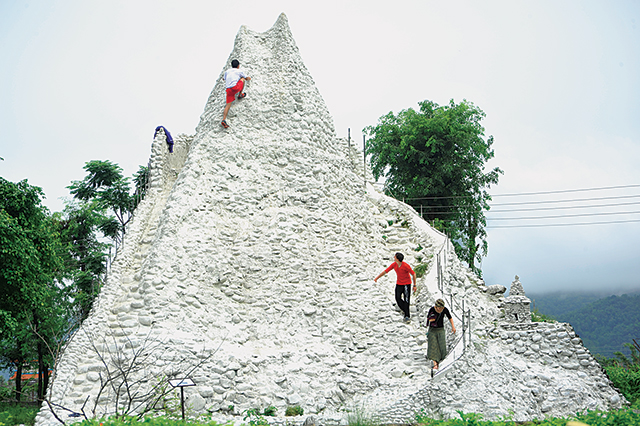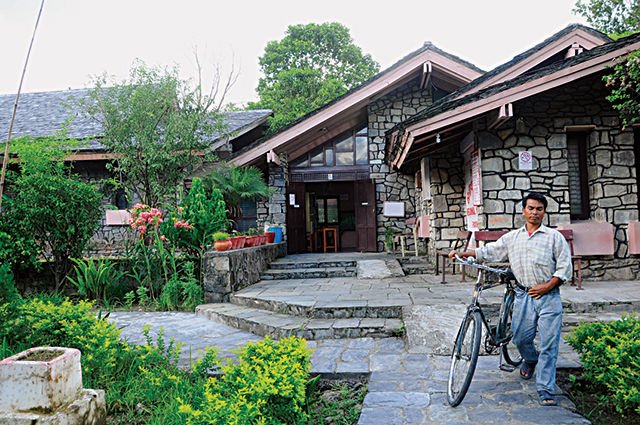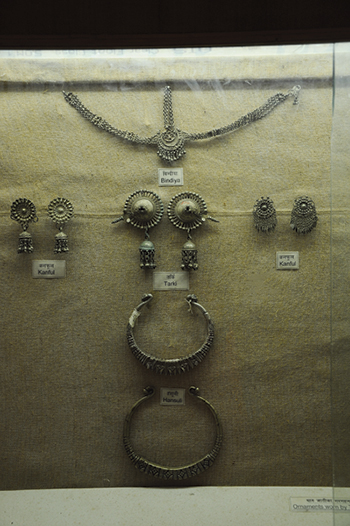Walking towards the main museum of the International Mountain Museum (IMM), you might get to see unripe coffee berries (if it’s the season of unripe coffee berries) hanging from the coffee bush to the right. On the left, a huge ground with a few small houses and a mock Mt Manaslu invites visitors to climb it. Further down the path, you will come across a Chorten in memory of those who have perished in the mountains, standing in full view of the museum. You instantly know that this museum is about the mountains and the lives of the people who live with it and around it.

The museum looks deceptively small. But once you enter the main museum, you will see that the basement and the first floor open up into several halls and galleries that exhibit life in mountains. The exhibits are divided into various halls like a Video Hall, Hall of Mountain People, Hall of Mountains, Hall of Mountain Activities, Hall of Associates’ Exhibition, a mock prayer room called Lakhang Room, and a library.

You first walk into the Video Hall to learn about the people, culture, lives and the mountains of the Khumbu region. The 18 minutes of video is an orientation and an introduction to life in the mountainous regions of Nepal. After the video, you walk towards the Hall of Mountain People where the lives of people from Japan, Slovenia, Taiwan and Nepal await you. The information on how they live, their culture and their way of life is showcased here. The Nepali section of the exhibit showcases many ethnic groups like Sherpa, Tamang, Magar, Kirant, Gurung, and Thakali among others. From kitchen wares to clothes, all information you require to study these groups are present here. Another interesting display is the comparison between the lives the Alpine mountain people in Nepal and Europe through photographs taken more than 50 years ago. You will see little Nepali children with sun burnt skin carrying chicken and little European children with fair skin carrying puppies. Although these photographs provide contrast between the lives in two different regions, you will also see how similar the way of life is.

The second hall is the Hall of Mountains where information on all 14 peaks over 8000m is available. You will be able learn the historical background of the mountains, especially the Himalayas (there is a monitor that shows, in animation, how the Himalayas were formed). While you will find some important rock samples that were part of the geological formation of the mountain range, the diverse flora and fauna found in this region are also presented in pictures and stuffed replicas. From this section, you will move to another one where the contributions of five prominent personalities – Dawa Norbu Sherpa, Kumar Khadga Bikram Shah, Dr. Toni Hagen, Reverend Ekai Kawaguichi and Dr. Harka Gurung are displayed. Named as the Corner of dedication, this section is a tribute to the people who have made immense contributions to the conservation of the mountain region.
 The third hall called Hall of Mountain Activities is where all the fun is. From equipments to clothes, various kinds of professional ropes to different mountaineers who were the first one to climb the untamed peaks are displayed. You will be able to see their notebooks among other personal items displayed here. At the same time the fourteen peaks are also shown in chronological order according to the year they were conquered. From there you will come across the mysterious Yeti section that delves into the legend and the tales of this mysterious creature. Here an alleged foot print and articles and publication on its appearance are on display. From this hall, you will come across a section dedicated to creating awareness about mountain ecology and environment. You will see a display of the garbage collected from Everest between the year 2000 and 2003 which will leave you wondering about what will happen in the future if proper care is not taken now. The last section in this hall is called Imaging Everest where you can see photographs of British Expedition to Mount Everest from 1921 to 1953.
The third hall called Hall of Mountain Activities is where all the fun is. From equipments to clothes, various kinds of professional ropes to different mountaineers who were the first one to climb the untamed peaks are displayed. You will be able to see their notebooks among other personal items displayed here. At the same time the fourteen peaks are also shown in chronological order according to the year they were conquered. From there you will come across the mysterious Yeti section that delves into the legend and the tales of this mysterious creature. Here an alleged foot print and articles and publication on its appearance are on display. From this hall, you will come across a section dedicated to creating awareness about mountain ecology and environment. You will see a display of the garbage collected from Everest between the year 2000 and 2003 which will leave you wondering about what will happen in the future if proper care is not taken now. The last section in this hall is called Imaging Everest where you can see photographs of British Expedition to Mount Everest from 1921 to 1953.
From the basement, you move to the first floor where if you are lucky, Mt Dhaulagiri, Mt Annapurna and Mt. Manaslu welcome you with a spectacular view. You can either sit down on the chairs enjoying the scenery for a while (taking some photographs as well) or go to the Hall of Associates’ Exhibition on the opposite side. Further information on the socio-economic life of the mountain people and their activities in various periods is presented in this hall. You will learn about the flora, fauna and the environment of the region through various exhibits which showcase the past, present and future activities of IUCN and ICIMOD. If you are visiting the museum with kids, the 39 quiz questions will surely be one of the favorite exhibits. Kept on tin folios these quizzes about the mountains helps to stimulate General Knowledge. After coming out from this hall, you can then either visit the library to learn more about the region (this library boasts a collection on various topics including climate, culture, Nepal, trekking and research among others) or go to the Lakhang room to pray, meditate and internalize the museum you’ve just seen. This room is a perfect representation of Tibetan Buddhist monasteries scattered across the mountain regions of Nepal.
After the museum, you can then visit the Living Museum and Gorkha Village Restaurant. Here you can see live examples of the culture of indigenous people of Nepal belonging to different ethnic groups. You will find cows and goats grazing in the pasture and houses painted with mud. The 31 foot tall model of Mt. Manaslu gives another way to enjoy this museum space. For more serious adventurers, a wall climbing facility is available near the entrance.
At the International Mountain Museum, you can spend hours with friends and family, walking through the interactive displays and information, or spend time alone in view of the glorious Himalayas. The museum is sure to show a side of Pokhara that you never imagined existed.










